
One of my favorite vegetables, fresh corn on the cob, is in season in the USA from May to September.
When buying corn, the husks (outer green covering) should be bright green and fit snugly around the ear of corn. The kernels should be in tight rows right to the tip of the ear of corn, and be plump and milky (if you accidently pop one!).
While in the grocery store, it is perfectly acceptable to peel back the outer green husk to check and see if the corn looks OK.
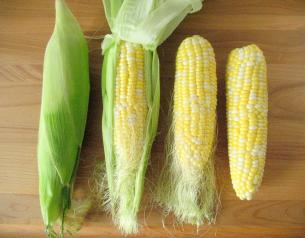
You should peel the husk off the corn just before you cook it. To do so, peel back the husk, hold the peeled ear of corn in one hand, the husk and stalk in the other and then snap off the stalk.
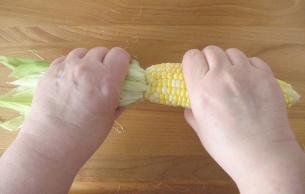
To remove the “silk” (the white hairy threads just under the husk) wet a paper towel and wipe down the corn – from the tip to the stalk end. Be sure to totally remove all the silk as it is really not pleasant to serve corn on the cob with the silky threads still attached.

Once the husk and silk have been removed from the corn, it is officially “shucked”.
I am going to show you three ways to cook corn on the cob:
- In the microwave
- On the stove top starting with cold water
- On the stove top starting with boiling water
You can also cook corn in a pressure cooker which is quick and (many people tell me) quite simple to do, but I still have yet to buy a pressure cooker.
Note:
Be sure to have a look in the comment section below as many experienced cooks have added some great suggestions on how they cook corn.
Method 1: Cooking Corn in the Microwave
Cooking corn in the microwave is my preferred method. I am not too fond of pots of boiling water heating up my kitchen on a hot summer day.
This method is good when you are cooking only 2 or 3 ears of corn. If you are cooking more, you should choose one of the other cooking methods or do it in batches in the microwave.
Place the corn in a microwave safe dish and add about 2 Tablespoons of water to the dish.
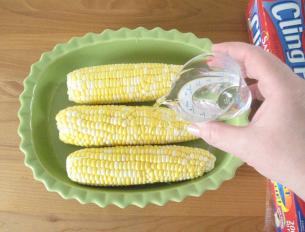
Cover the dish with plastic wrap, making sure to leave a small opening (a steam vent) in the corner to let the steam escape.

Microwave the corn on high for 4-to-6 minutes – depending on the strength of your microwave.
Carefully remove the plastic wrap from the corn. There will be a lot of very hot steam escaping, so you probably should use a pair of tongs to remove the plastic wrap.
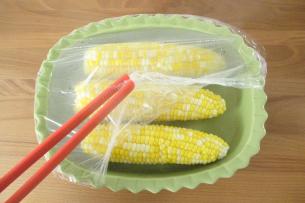
Method 2: Cooking Corn on the Stovetop Starting with Cold Water
Place the shucked corn in a large pot. Cover it with COLD tap water. Cover the pot and set it on the stove. Bring the pot to a boil. Once the pot has reached a boil, the corn is cooked.

Method 3: Cooking Corn on the Stovetop Starting with Boiling Water
Fill a large pot half way with COLD water. There should be enough water in the pot so that when you add the corn, it is covered with water but not overflowing.
Bring the pot of COLD water to a boil. Using a pair of tongs, carefully drop each ear of corn into the pot.
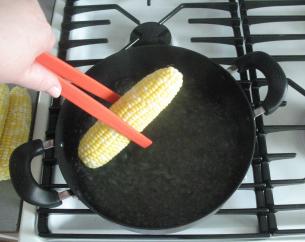
Cover the pot and return the water to a boil.

Boil the corn for 5-7 minutes or until done.
Cooking Corn Do’s and Don’t’s:
How do I know when it’s cooked?
The cooking times listed above are general cooking times. Some people eat corn raw, and some dunk it in boiling water for 30 seconds to just heat it slightly. The simplest answer is to taste the corn to see if it cooked to your liking. Over-cooked corn does become really tough and it is also pretty rough on the digestive track!
Should I add Salt or Sugar to the cooking water?
Corn is naturally sweet. Some people add 1-2 teaspoons of sugar to the cooking water to sweeten it even more. That’s totally up to you!
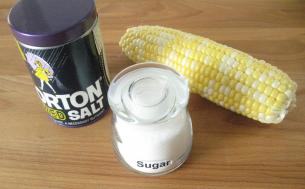
Salt, on the other hand, should not be added to the cooking water as it will toughen the corn. Sprinkle it on after the corn is cooked.
Ice Bath:
When blanching vegetables, like asparagus, you plunge the partially cooked asparagus into a bowl of ice water to stop the cooking process.
If you are cooking the corn for other uses than eating it off the cob, you may be tempted to submerge it in a bowl of icy water to cool it off. Don’t! It will cool the corn off BUT it will also turn your corn very soggy.
Storage:
Cook and eat corn on the cob the same day as you buy it.
To freeze fresh corn on the cob you must remove the corn from the cob first. It can be cooked or uncooked when you remove it from the cob to freeze. To remove the corn from the cob, a serrated knife works best.
Corn can be frozen for up to six months.
Corn Holders:
I really like these things! They do come in all shapes and sizes. You just jam them in either end of the corn cob. If the corn is really hot, they protect your fingers. They also have other uses. I actually used the big ones in the photo below to help peel a mango!
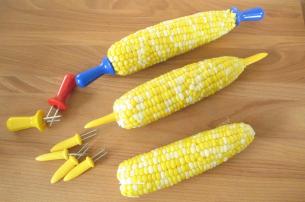
Buttering Corn:
One way to butter corn is to slide the corn in a circular motion over a stick of butter. Alas, the whole family really has to agree to this method!
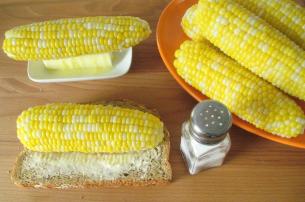
Or you could butter a piece of bread and roll the corn in the slice of bread.
Or, you can of course just dab a bit of butter on each piece with your dinner knife and then sprinkle on some salt and…
Enjoy!
If you are new to startcooking, or are a regular visitor here, please consider subscribing for free.








































taf said:
Corn on the cob is great microwaved in the husk also, as a plus no extra dishes.